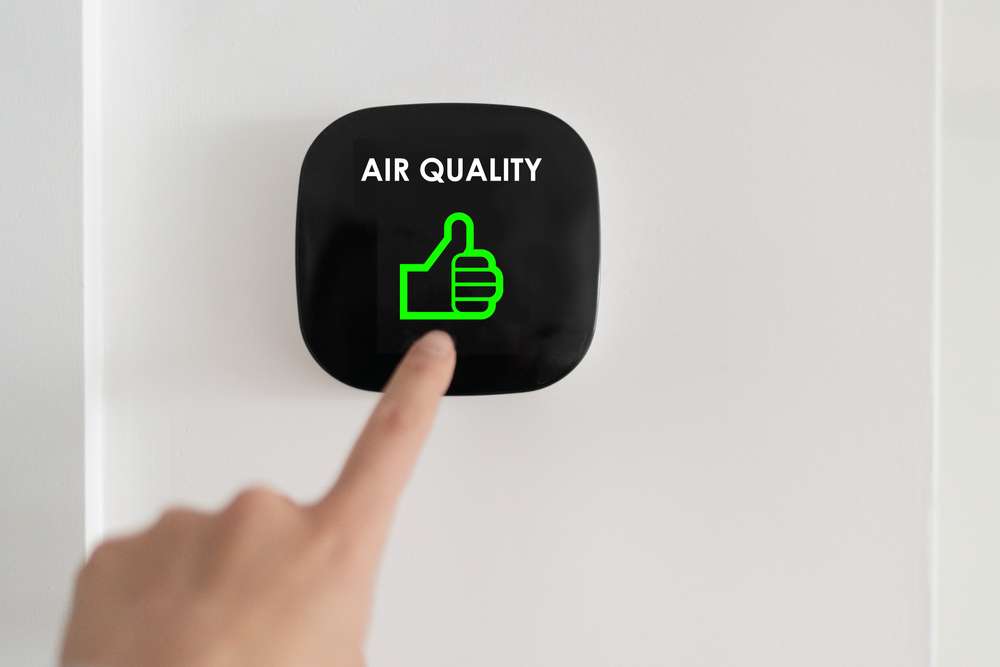Without good health, it’s hard to live life well. Indoor air is a big part of that health, so it’s worth knowing how to make that air as good for us as it can be. So, how can you improve indoor air quality?
You can improve indoor air quality in a lot of ways. The top 10 ways are to improve ventilation, get an air purifier, clean regularly and safely, do source control, run exhaust fans, limit aerosols and scented items, don’t smoke, radon test, change air filters regularly, and control humidity.
Why Indoor Air Quality Matters

According to the United States Environmental Protection Agency (EPA), indoor air is 2 to 5 times more polluted than outdoor air. This is a big deal because, as the EPA also points out, people tend to spend 90% of their time indoors. That gives people a lot of chances to breathe in all the dust, dander, pollen, viruses, bacteria, and even gases that can be in their air.
How Indoor Air Quality Affects Health
Before talking about air quality and health, please remember to always consult with a doctor for any medical concerns or advice. Also, consider scheduling an appointment with a heating, ventilation, and air conditioning (HVAC) technician to get ideas on how to improve your HVAC system.
That said, indoor air quality can affect people’s health in both the short and long term. In the short term, people might be dealing with irritated eyes, nose, and throat, headaches, and dizziness. In the long term, it’s possible to develop respiratory diseases or even cancer. There’s also something called sick building syndrome.
What Is Sick Building Syndrome?
Sick building syndrome is when people go into a building and develop similar symptoms such as irritated eyes, nose, and throat, headaches, dizziness, and others, but there’s no other known cause. Once the people leave that building, their symptoms tend to go away.
So, there are several health issues indoor air can cause, but what causes it to have poor quality?
Causes Of Indoor Air Pollution
There are 2 types of causes of poor indoor air quality: particulate matter and gaseous pollutants.
Cause #1 – Particulate Matter
Particulate matter refers to things like dust, dander, pollen, bacteria, and viruses. Some ways these can end up in the air are when people sneeze or cough or from bringing them in on their shoes or clothes.
Cause #2 – Gaseous Pollutants
Gaseous pollutants are gases that pollute our air. These can be things like carbon monoxide, ground-level ozone, nitrogen oxide, radon, and others. These are a bit harder to deal with than particulate matter, but it is possible.
So, how do you deal with all these pollutants?
The Top 10 Tips For Improving Indoor Air Quality

Tip #1. Improve Ventilation
Ventilation refers to how much and how well outdoor air comes in to replace indoor air. There are several ways to go about improving ventilation in a home.
Open The Windows
When possible, open as many windows as you can. Leaving them open gives outdoor air more opportunities to make its way into your home or office, thus refreshing the air there and allowing pollutants more ways to get out.
Clean The Vents
The vents in your home help allow in that fresh air, but they also accumulate dust and other things. Clean them regularly to ensure they’re not spreading those things into the air.
Schedule An HVAC Appointment
Your HVAC system already provides some ventilation (although not all do). It’s still worthwhile though to schedule an appointment to see if there are ways to improve your system even further.
Tip #2. Get An Air Purifier
Even with improved ventilation, getting an air purifier gives you that extra edge for dealing with pollutants. Many air purifiers can be used to purify whole rooms, but you can go with air scrubbers too, which attach to your HVAC system.
Tip #3. Clean Regularly And Safely
Cleaning regularly is an important part of keeping a home looking nice. Cleaning regularly also removes any pollutants that have settled onto floors and counters. What about cleaning other parts of the home though?
Clean Rugs, Carpets, Furniture, And Curtains
Pollutants like dust, dander, and pollen can end up on rugs, carpets, furniture, and curtains. They stay there until they’re sent back into the air by different human activities. Taking the time to regularly clean these parts of the home helps keep these pollutants from getting back into the air.
Use Safe Cleaners
Some cleaners do more harm than good. This is because they can release gases into the air, which can then end up in the lungs. When choosing cleaners, look for ones that are more naturally based and use less harsh chemicals.
Tip #4. Source Control
Sometimes the best thing to do is get rid of the things that are causing the issues. For example, it’s better to have mold and mildew removed than to let it sit.
Tip #5. Run Exhaust Fans
Most homes will have exhaust fans in the kitchen and bathroom. Running these while cooking or showering helps remove things that can end up in our air and cause problems. Cooking with gas, wood, or electricity, for example, can send pollutants into the air. Showering can increase the moisture in the bathroom, which can lead to mold or mildew.
Tip #6. Limit Aerosols And Scented Items
Aerosols and scented items send more pollutants into the air, so try to use them as little as possible. When using them, have at least one open window or an exhaust fan running.
Tip #7. Don’t Smoke
Not only does smoking impact health just from smoking, but the chemicals smoking releases can stick around in the air. Smoking outside is an option, but it would be best to stop smoking at all.
Tip #8. Test For Radon
Radon is a naturally occurring gas that many home inspections will offer to test for it. There are also free tests offered by some organizations. Radon can cause things like lung cancer, so it’s worth seeing how much of it is in your home and what you can do about it.
Tip #9. Regularly Change Air Filters
Whether it’s an air purifier or your HVAC system, change the filters according to manufacturer recommendations. Over time, filters will get dirty and be unable to trap as many pollutants, so changing them regularly keeps them working as well as they can be.
Tip #10. Control Humidity
If your house is too humid, it can lead to things like mold and mildew, which can end up in your air. Dehumidifiers can help with this by drawing moisture out of the air.
Key Takeaways: How Can You Improve Indoor Air Quality?
Thankfully, when it comes to “how can you improve indoor air quality,” there are lots of ways to do so. Don’t feel like you have to do it all at once though. Start with one thing then go on to another.
So, which one are you most excited to try first? Why? Have you used some already? How did it go? Let us know in the comments below!

